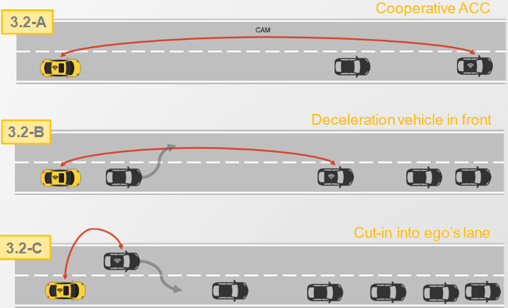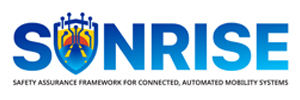UC3.2 – Cooperative perception & decision making & control
The primary objective of sub-UC 3.2 is to demonstrate how safety can be enhanced on motorways by integrating cooperative functions into the Highway Pilot (HWP) system.
Variation of interesting parameters, including corner cases and safety-critical conditions, can be demonstrated first through virtual tests and then proven in real world scenarios, providing sufficient test coverage of the ODD.
Use case overview
UC3.2-A: Validate C-ACC Cooperative Adaptive Cruise Control with horizon extended beyond the immediately leading vehicle via V2V.
UC3.2-C1: Logical scenario 1. Test an automated driving system (ADS) equipped with V2V communication, assessing its response to careless merging communicated on highways, and evaluating its ability to avoid collisions.
UC3.2-C2: Logical scenario 2. Test two automated driving systems (ADS) equipped with V2V communication, assessing their negotiated merge on highways.
Objectives
By applying the SAF, demonstrate how safety and surrounding awareness can be improved on highways by including cooperative V2X communication with surrounding vehicles.
SAF blocks demonstrated
UC3.2-A

UC3.2-C1

UC3.2-C2

Safety case setup
UC3.2-A
UC3.2-C1
Three different self-driving systems:
- A cognitive self-driving agent
- A traditional path planner
- A generalized Intelligent Driver Model (IDM)
Test environments
UC3.2-A: Virtual and physical testing
UC3.2-C: Simulation in IPG CarMaker
Safety case building
UC3.2-A
- Scenario space coverage
- Safety evidence: Microscopic evaluation (on individual scenarios) of pass/fail results
- Safety case pass/fail binary result
- Test scenario allocation and re-allocation if needed in higher fidelity test environment
- Co-simulation framework execution
- Risk-oriented testing: Boundary scenarios identification
- Test scenario prioritization (based on scenario criticality, exposure and complexity as per ISO 34505)
- Modular approach: Independent subsystems & End-to-end system testing (Open-Loop / Closed-Loop)
- Combine results from different test environments to argue ‘macroscopic’ safety margin violation for one logical scenario
- Verification of simulation results through Proving Ground
UC3.2-C1
- Safety evidence
- Microscopic evaluation of individual scenarios results
- Macroscopic evaluation (statistical analysis) of aggregated results
- Derivation of a safe speed recommendation function
- Coverage-oriented testing
- Risk-oriented testing
- Risk assessment
- Failure model analysis
- Safe speed recommendation
UC3.2-C2
- Safety evidence
- Microscopic evaluation of individual scenarios results
- Macroscopic evaluation (statistical analysis) of aggregated results
- Risk-oriented testing
- Risk assessment
- Merge success rate
Test scenarios selected
• 3.2-A: Cooperative ACC
• 3.2-B: Deceleration vehicle in front
• 3.2-C: Cut-in into ego’s lane

